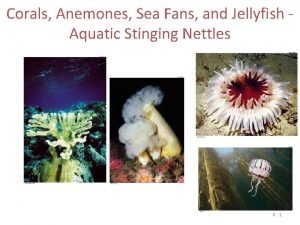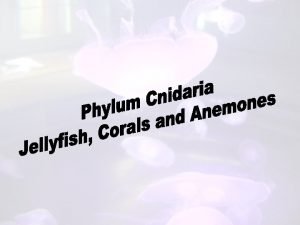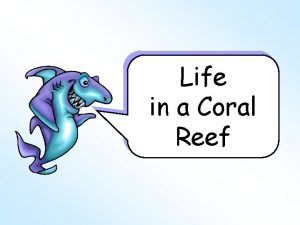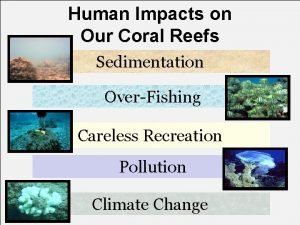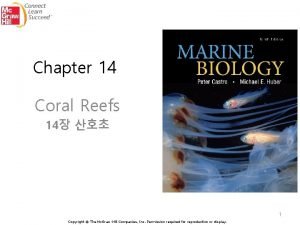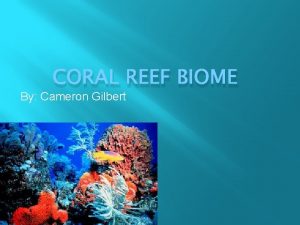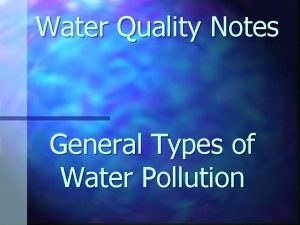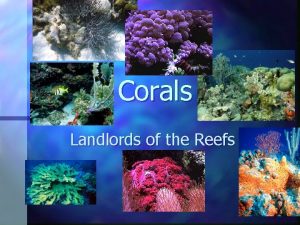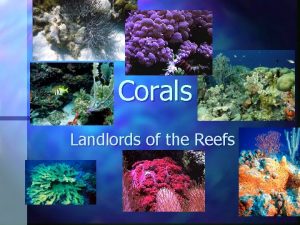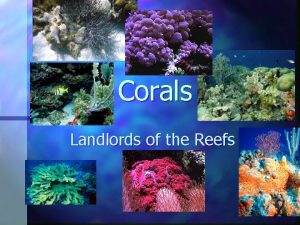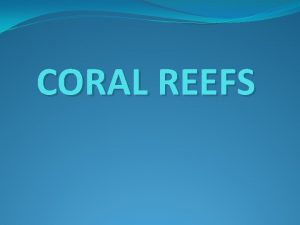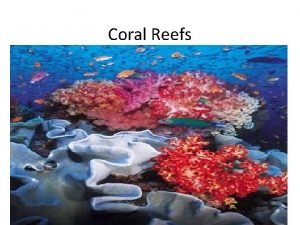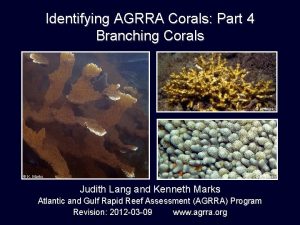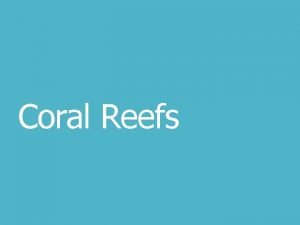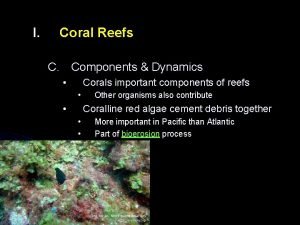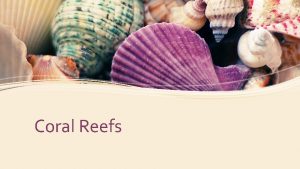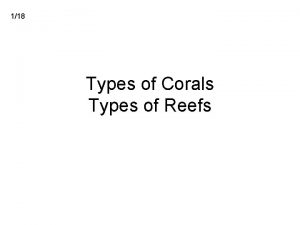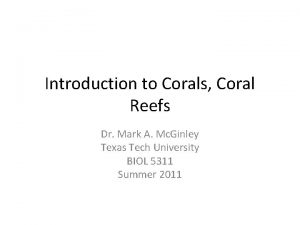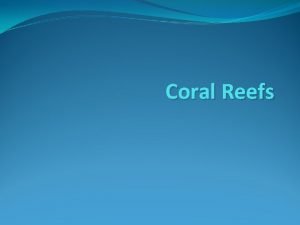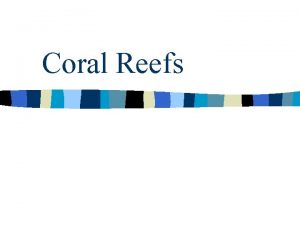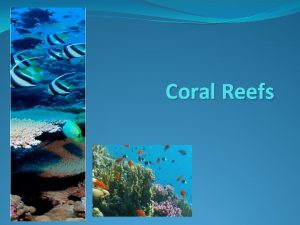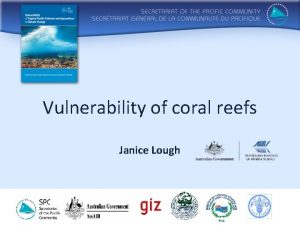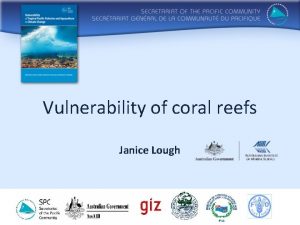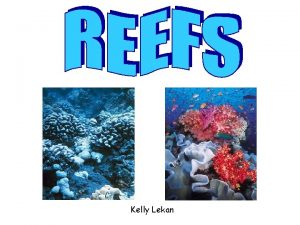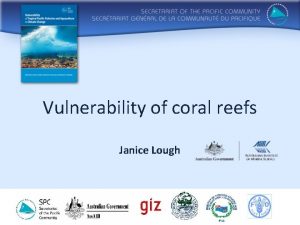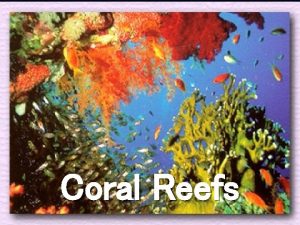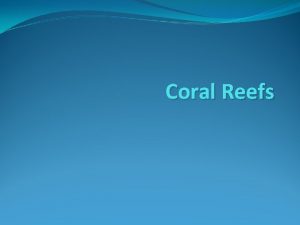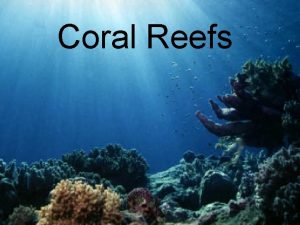Corals Landlords of the Reefs What are corals




















































- Slides: 52

Corals Landlords of the Reefs

What are corals? They are animals! n Plants live inside of them n Two kinds n n Soft corals Hard corals (These build reefs!) They are made of coral polyps (which look like upside-down jellyfish)

Hard Corals: The Reef Builders Polyps build hard limestone cups around their bases n The cups cement together to make a coral colony n Reefs are made of hundreds of hard coral colonies next to and on top of each other n

Soft Corals Soft corals are composed of fibrous protein, which makes them flexible n Soft corals look more like plants under water…since they sway back and forth n

Coral Structure: The basic structure of the coral animal is the coral polyp…which resembles a small sea anemone n Corals are in the same class as sea anemones, because they perform life activities the same way (ingestion, digestion, sensitivity, exchange of gases, reproduction, etc. ) n

What’s a Polyp? Tentacles release stinging cells (nematocysts) when something brushes by them n Polyps make their own limestone cup to hide in during the day n At night, polyps come out to catch plankton floating by. n

Video types and function



Coral Polyps… n The coral polyp is a tiny mound of tissue that contains a saclike digestive tract and a mouth surrounded by stinging tentacles (nematocysts) n In hard corals, each polyp sits in a limestone cup (calyx), that is added to year after year developing into a coral reef.

Coral Polyps

Coral Polyps Extended for Feeding

Coral Polyps… n However, unlike sea anemones, coral polyps live in large groups as colonial animals, attached to one another through a thin membrane

video

Zoo-what!? ! Algae, Coral Polyps’ Tenants n Inside polyps live zooxanthellae, which are algae. n Zooxanthellae give corals their color. n Since algae are plants, they use sunlight and CO 2 to make food (photosynthesis). Zooxanthellae benefit from living safely within the coral polyps cells…receiving nutrients n Corals also get oxygen from the zooxanthellae! n

Symbiosis: So Happy Together n Two organisms living together and helping each other is an example of Mutualistic symbiosis. Zooxanthellae make oxygen, remove the polyp’s wastes, and make food for the polyp from photosynthesis. n Coral polyps protect the zooxanthellae, release CO 2, and provide it with necessary nutrients from their own waste. n

Symbiotic Relationships n Mutualistic: n Win/Win - both organisms benefit Ex: n Commensalism: Win/unaffected – One organism benefits the other not helped or harmed. n Ex: n Parasitism: Win/lose- One benefits while the other is harmed. n Ex:

Prilfish and Cleaner shrimp are another common reef species, and they can be spotted at any number of “stations” where multiple marine species meet to have their mouths and bodies rid of parasites and dead cells. The cleaner shrimp feeds continuously, and the larger species gets to start the week fresh with no blemishes. Sea Cucumber and Imperial Shrimp The Imperial shrimp and the sea cucumber can be seen as fast friends of the sea. The Imperial shrimp utilizes the sea cucumber for its locomotive purposes, hanging tight through waters filled with the shrimp’s food source, only disembarking to have a bite, and then climbs aboard to further its travel to the next feeding ground. Whale and Barnacle

Where are coral reefs located? n Most coral reefs are found in the tropical and subtropical regions of the world, between 30 degrees north and 30 degrees south latitude. n Corals require warm, clear water and plenty of sunlight n These conditions allow the Zooxanthalae to grow and help build the reefs

Coral Reef Locations…

Coral Reefs… n Coral reefs can grow upward at 2. 5 cm/year! n Coral reefs are damaged by ships scraping the ocean bottom, trawl nets, tourists breaking them apart, severe storms, excess sediment or pollution, or temperatures that are too warm (global warming).


Coral Types: n Each coral type has its own unique shape, size, color, and texture. n Corals are named after familiar objects that they resemble Examples: n Elkhorn coral n Staghorn coral n Brain coral n

Staghorn & Brain Corals


Video

Coral Reefs… n Corals bleaching occurs when the polyps are under stress…and they expel their zooxanthellae! n Increase or decrease in water temp.

video

Coral Reef Development n As the corals grow and expand, reefs take on one of three major characteristic structures —fringing, barrier or atoll.

Fringing reef Barrier reef Atoll a b c Fig. 12 -28 a-c, p. 335

Fringing Reefs… n Fringing reefs, which are the most common, project seaward directly from the shore, forming borders along the shoreline and surrounding islands.

Fringing reef is one of the three main types of coral reefs recognized by most coral reef scientists. n It is distinguished from the other two main types (barrier reefs and atolls) in that it has either an entirely shallow backreef (area between the reef and the land) zone or none at all. If a fringing reef grows directly from the shoreline the reef flat extends right to the beach and there is no backreef. n This type of coral reef is the most common type of reef found in the Caribbean and Red Sea. Darwin believed that fringing reefs are the first kind of reefs to form around a landmass in a long-term reef growth process. n

Fringing reef

Barrier Reefs… n Barrier reefs also border shorelines, but at a greater distance. They are separated from their adjacent land mass by a lagoon of open, often deep water.

n Barrier Reefs are separated from land by a lagoon. They tend to occur at lower latitudes than fringing reefs and can form around the islands or in lines parallel to continental shores. n The Great Barrier Reef, located in Queensland Australia, isn’t a single reef but a conglomerate of more than 3000 interlinked segments. It is the largest structure made from living organisms on Earth.

Barrier

Atoll n The atoll gets its start when a deep-sea volcano erupts to build a volcanic island. Corals soon colonize the shores of the new island a fringing reef develops. Coral growth is the greatest at the outer edge. n The island slowly sinks, the reef gets flat wider and deeper. Once the island sinks completely you are left with an atoll.

Atolls… n If a fringing reef forms around a volcanic island that subsides completely below sea level while the coral continues to grow upward, an atoll forms. Atolls are usually circular or oval, with a central lagoon. Parts of the reef platform may emerge as one or more islands, and gaps in the reef provide access to the central lagoon

Fig. 12 -28 d, p. 335

video

Human Impacts on the Coral Reef Environment… n Human-caused, or anthropogenic activities are major threats to coral reefs. n Pollution, overfishing, destructive fishing practices using dynamite or cyanide, collecting live corals for the aquarium market and mining coral for building materials are some of the many ways that people damage reefs all around the world every day.

Coral reefs in danger. video

Healthy Coral Reefs Provide: Income: Billions of Dollars for U. S. Economy, Millions of Jobs Healthy coral reefs support commercial and subsistence fisheries as well as jobs and businesses through tourism and recreation. n Local economies also receive billions of dollars from visitors to reefs through diving tours, recreational fishing trips, hotels, restaurants, and other businesses based near reef ecosystems. n

Healthy Coral Reefs Provide: Coastal Protection: A Natural Storm Barrier for Homes and Beaches The coral reef structure buffers shorelines against waves, storms and floods, helping to prevent loss of life, property damage and erosion. n When reefs are damaged or destroyed, the absence of this natural barrier can increase the damage to coastal communities from normal wave action and violent storms. n

Healthy Coral Reefs Provide: n Habitat: Home for 1 Million Species Coral reefs support more species per unit area than any other marine environment, and are living museums that reflect thousands of years of history. n Today, many human activities threaten these important habitats.

Healthy Coral Reefs Provide: n Medicines: Treatments for Heart Disease, Cancer and HIV Coral reefs are considered by some scientists to be the medicine cabinets of the 21 st century. n Coral reef plants and animals are important sources of new medicines being developed to treat cancer, arthritis, heart disease, viruses, and other diseases.

Healthy Coral Reefs Provide: n Recreation: Billions of Tourist Dollars for U. S. Economy Every year, millions of scuba divers, snorkelers and fishermen visit U. S. coral reefs. An even larger number of tourists visit the beaches that are protected by U. S. coral reefs. n Despite their great economic and recreational value, coral reefs are threatened by pollution, disease and habitat destruction.

Coral Reef Task Force: n In 1998, the President of the United States established the Coral Reef Task Force (CRTF) to protect and conserve coral reefs. The goals of this group are to: n n n lead U. S. efforts to protect, restore and provide for the sustainable use of coral reef ecosystems. The CRTF is charged to map and monitor all U. S. -held coral reefs; funding research to identify the major causes and consequences of coral reef degradation; working to conserve and restore coral reefs worldwide; and working with governments, scientific and environmental organizations, and the commercial sector to reduce coral reef destruction and restore damaged coral reefs.

Summary video

Protecting Coral Reefs: n Using high-resolution satellite imagery and Global Positioning Satellite (GPS) technology, comprehensive digital maps have been made of reefs in Puerto Rico, the U. S. Virgin Islands, the eight main Hawaiian Islands and the Northwestern Hawaiian Islands. This high resolution image of the French Frigate Shoals in the Northwestern Hawaiian Islands group was taken by the Landsat 7 satellite.

Remote Sensing… Remote sensing and satellite imagery play important roles in mapping, monitoring and protecting coral reefs, but there is no substitute for onsite evaluation. n In addition to the remote monitoring work conducted by satellites and buoys, NOAA’s National Undersea Research Program (NURP) conducts reasearch, assessment and restoration projects of coral reefs in marine reserves and among deep sea coral banks. n

Camo n http: //www. telegraph . co. uk/news/earth/ea rthpicturegalleries/74 20825/Camouflagedanimals-playing-hideand-seek-by-blending -into-thebackground. html http: //www. boredpanda. com/ani mal-camouflage-wolfe/
 Antigentest åre
Antigentest åre Private landlords tamworth
Private landlords tamworth Landlords horne
Landlords horne The jellyfish
The jellyfish Corals radial symmetry
Corals radial symmetry Disappearing corals module c
Disappearing corals module c Ivorn
Ivorn Carnivores in coral reefs
Carnivores in coral reefs Coral reef characteristics
Coral reef characteristics Detailed lesson plan about coral reefs
Detailed lesson plan about coral reefs Does overfishing affect coral reefs
Does overfishing affect coral reefs Great barrier reef food web
Great barrier reef food web Coral reefs biomes
Coral reefs biomes Water pollution through the years
Water pollution through the years Competition in coral reefs
Competition in coral reefs Thế nào là hệ số cao nhất
Thế nào là hệ số cao nhất Lp html
Lp html Hệ hô hấp
Hệ hô hấp Tư thế ngồi viết
Tư thế ngồi viết Các số nguyên tố
Các số nguyên tố đặc điểm cơ thể của người tối cổ
đặc điểm cơ thể của người tối cổ Cách giải mật thư tọa độ
Cách giải mật thư tọa độ Các châu lục và đại dương trên thế giới
Các châu lục và đại dương trên thế giới Glasgow thang điểm
Glasgow thang điểm ưu thế lai là gì
ưu thế lai là gì Thẻ vin
Thẻ vin Cái miệng nó xinh thế chỉ nói điều hay thôi
Cái miệng nó xinh thế chỉ nói điều hay thôi Các châu lục và đại dương trên thế giới
Các châu lục và đại dương trên thế giới Từ ngữ thể hiện lòng nhân hậu
Từ ngữ thể hiện lòng nhân hậu Bổ thể
Bổ thể Tư thế ngồi viết
Tư thế ngồi viết V cc cc
V cc cc Phép trừ bù
Phép trừ bù Thơ thất ngôn tứ tuyệt đường luật
Thơ thất ngôn tứ tuyệt đường luật Alleluia hat len nguoi oi
Alleluia hat len nguoi oi Hổ sinh sản vào mùa nào
Hổ sinh sản vào mùa nào đại từ thay thế
đại từ thay thế Diễn thế sinh thái là
Diễn thế sinh thái là Vẽ hình chiếu vuông góc của vật thể sau
Vẽ hình chiếu vuông góc của vật thể sau Cong thức tính động năng
Cong thức tính động năng Thế nào là mạng điện lắp đặt kiểu nổi
Thế nào là mạng điện lắp đặt kiểu nổi Tỉ lệ cơ thể trẻ em
Tỉ lệ cơ thể trẻ em Lời thề hippocrates
Lời thề hippocrates Vẽ hình chiếu đứng bằng cạnh của vật thể
Vẽ hình chiếu đứng bằng cạnh của vật thể độ dài liên kết
độ dài liên kết Quá trình desamine hóa có thể tạo ra
Quá trình desamine hóa có thể tạo ra Các môn thể thao bắt đầu bằng tiếng nhảy
Các môn thể thao bắt đầu bằng tiếng nhảy Hình ảnh bộ gõ cơ thể búng tay
Hình ảnh bộ gõ cơ thể búng tay Sự nuôi và dạy con của hổ
Sự nuôi và dạy con của hổ điện thế nghỉ
điện thế nghỉ Các loại đột biến cấu trúc nhiễm sắc thể
Các loại đột biến cấu trúc nhiễm sắc thể Nguyên nhân của sự mỏi cơ sinh 8
Nguyên nhân của sự mỏi cơ sinh 8 Trời xanh đây là của chúng ta thể thơ
Trời xanh đây là của chúng ta thể thơ



